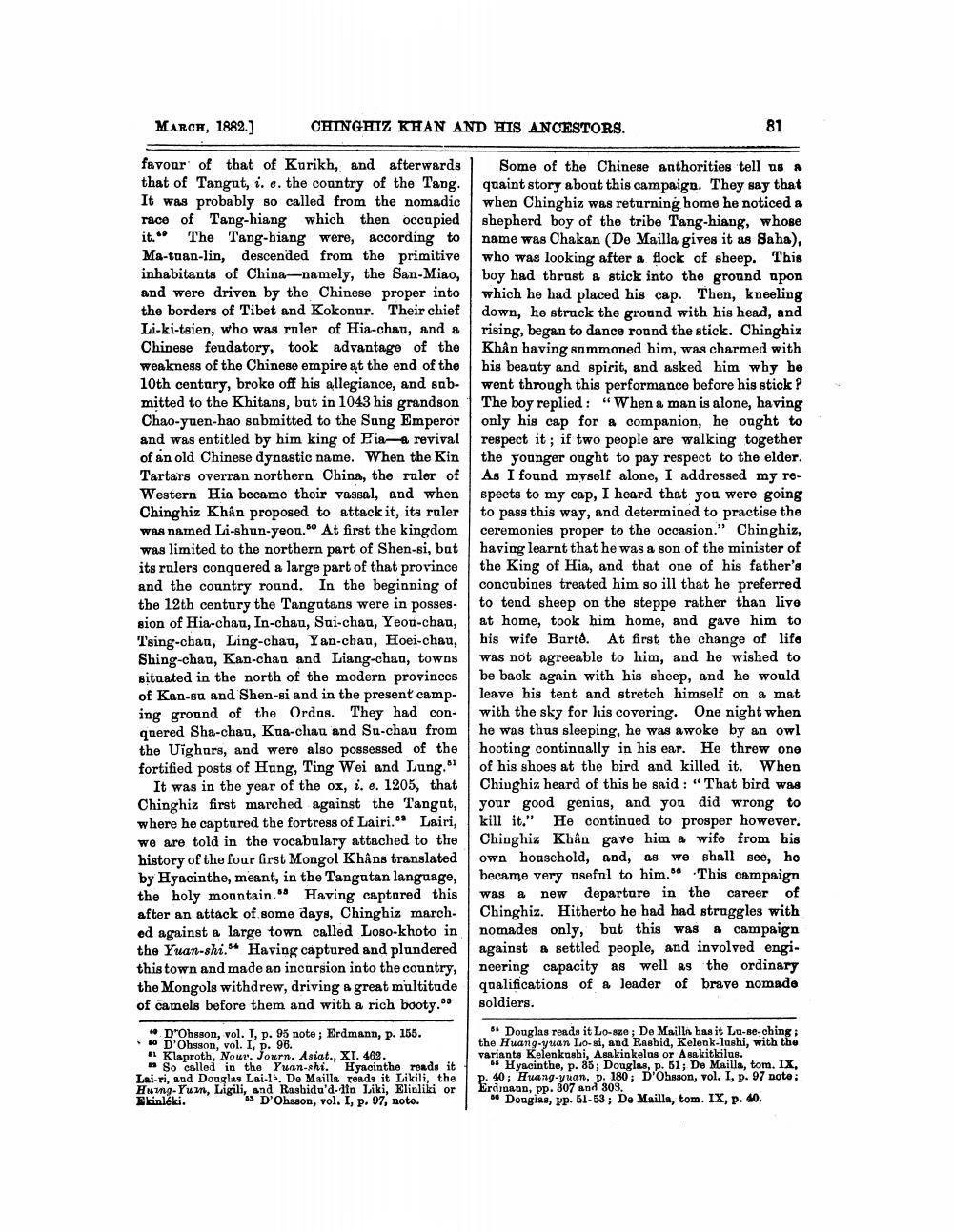________________
MARCH, 1882.]
CHINGHIZ KHAN AND HIS ANCESTORS.
81
favour of that of Kurikh, and afterwards that of Tangut, i. e. the country of the Tang. It was probably so called from the nomadic race of Tang-hiang which then occupied it. The Tang-biang were, according to Ma-tuan-lin, descended from the primitive inhabitants of China-namely, the San-Miao, and were driven by the Chinese proper into the borders of Tibet and Kokonur. Their chief Li-ki-tsien, who was ruler of Hia-chan, and a Chinese feudatory, took advantage of the weakness of the Chinese empire at the end of the 10th centary, broke off his allegiance, and sab. mitted to the Khitans, but in 1043 his grandson Chao-yuen-hao submitted to the Sung Emperor and was entitled by him king of Lia- revival of an old Chinese dynastic name. When the Kin Tartars overran northern China, the ruler of Western Hia became their vassal, and when Chinghiz Khân proposed to attack it, its ruler was named Li-shun-yeon." At first the kingdom was limited to the northern part of Shen-si, but its rulers conquered a large part of that province and the country round. In the beginning of the 12th century the Tangutans were in posses. sion of Hia-chan, In-chau, Sui-chan, Yeon-chau, Tsing-chan, Ling-chau, Yan-chau, Hoei-chau, Shing-chau, Kan-chan and Liang-chan, towns situated in the north of the modern provinces of Kan-su and Shen-si and in the present camping ground of the Ordas. They had con- quered Sha-chau, Kua-chau and Su-chau from the Uighurs, and were also possessed of the fortified posts of Hung, Ting Wei and Lung,
It was in the year of the ox, i. e. 1205, that Chinghiz first marched against the Tangat, where he captured the fortress of Lairi." Lairi, we are told in the vocabulary attached to the history of the four first Mongol Khâns translated by Hyacinthe, meant, in the Tangatan language, the holy mountain." Having captured this after an attack of some days, Chinghiz marched against a large town called Loso-khoto in the Yuan-shi. Having captured and plundered this town and made an incursion into the country, the Mongols withdrew, driving a great multitude of camels before them and with a rich booty."
Some of the Chinese anthorities tell us a quaint story about this campaign. They say that when Chinghiz was returning home he noticed a shepherd boy of the tribe Tang-hiang, whose name was Chakan (De Mailla gives it as Saha), who was looking after a flock of sheep. This boy had thrust a stick into the ground upon which he had placed his cap. Then, kneeling down, he struck the ground with his head, and rising, began to dance round the stick. Chinghiz Khân having summoned him, was charmed with bis beauty and spirit, and asked him why be went through this performance before his stick ? The boy replied: "When a man is alone, having only his cap for a companion, he ought to respect it, if two people are walking together the younger ought to pay respect to the elder. As I found myself alone, I addressed my respects to my cap, I heard that you were going to pass this way, and determined to practise the ceremonies proper to the occasion." Chinghiz, having learnt that he was a son of the minister of the King of Hia, and that one of his father's concubines treated him so ill that he preferred to tend sheep on the steppe rather than live at home, took him home, and gave him to his wife Burtë. At first the change of life was not agreeable to him, and he wished to be back again with his sheep, and he would leave his tent and stretch himself on a mat with the sky for his covering. One night when he was thus sleeping, he was awoke by an owl hooting continually in his ear. He threw one of his shoes at the bird and killed it. When Chinghiz heard of this he said: "That bird was your good genins, and you did wrong to kill it." He continued to prosper however, Chinghiz Khân gave him a wife from his own household, and, as we shall see, he became very useful to him. This campaign was a new departure in the career of Chinghiz. Hitherto he had had struggles with nomades only, but this was a campaign against & settled people, and involved engineering capacity as well as the ordinary qualifications of a leader of brave nomade soldiers.
D'Ohsson, vol. I, p. 95 note; Erdmann, p. 155. * D'Ohsson, vol. I, p. 96. #1 Klaproth, Nout'. Journ. Asiat., XI. 462.
* So called in the Yuan-rhi. Hyacinthe roads it Lai-ri, and Douglas Lai-14. De Mailla reads it Likili, the Huing-Yum, Ligili, and Rasbidu'd. in Liki, Elinliki or Elinlēki. 63 D'Ohsson, vol. I, p. 97, note.
5. Douglas reads it Lo-sze ; De Mailla has it Lu-se-ching : the Huang-yuan Lo-si, and Rashid, Kelenk-loshi, with the variants Kelenkashi, Asakin kelas or A sakitkilus.
6 Hyacinthe, p. 88; Douglas, p. 51; De Mailla, tom. IX, P. 40; Huang-yuan, p. 180; D'Ohsson, vol. I, p. 97 note; Erdmann, pp. 307 and 309.
10 Douglas, vp. 51-53; De Mailla, tom. IX, p. 40.




